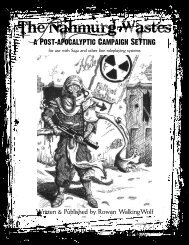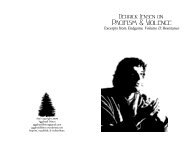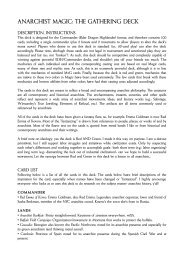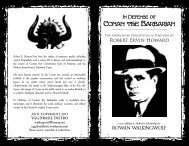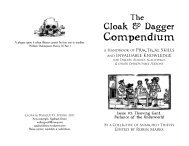Hyboria - WordPress.com - Yggdrasil Distro
Hyboria - WordPress.com - Yggdrasil Distro
Hyboria - WordPress.com - Yggdrasil Distro
Create successful ePaper yourself
Turn your PDF publications into a flip-book with our unique Google optimized e-Paper software.
Brythunian Brythunian Infantry<br />
Brythunia is a loosely-knit <strong>Hyboria</strong>n kingdom<br />
of city-states. Its Nemedian frontier is the<br />
north-flowing Yellow River. Another river<br />
flowed eastward along the Brythunian side of<br />
the Graaskal Mountains and marked the<br />
northern border. The highlands in the<br />
northeast were cleft by numerous passes,<br />
through which Hyrkanian invaders poured<br />
during the years following the Age of<br />
Conan. Interior Brythunia was a land of<br />
fertile, subhumid prairies interspersed with<br />
very thick, wolf-haunted coniferous forests.<br />
Brythunia is primarily agricultural, with its<br />
aristocracy based upon land-owning boyars who made their headquarters in the fortified cities. The most<br />
fertile soils were found in the alluvial deposits of the interior river valleys and in the southern piedmont.<br />
The folk of Brythunia have the dubious honor of serving as traditional butts of <strong>Hyboria</strong>n Age humor<br />
which paints Brythunian men as thickwitted oafs and their women as saucy and willing wenches. The<br />
women of Brythunia, mostly blonde, spirited and beautiful, are much sought after by slave traders.<br />
Modern Brythunians descend from ancient Hyperborean and Brythunian stock. Hyperboreans were<br />
stocky (like modern Shemites), with dark hair; ancient Brythunians were tall, fair-skinned and blond.<br />
Modern Brythunians are stocky, but with fair skin and blond hair.<br />
Most Brythunians live in small villages of wattle-and-daub huts. In the central regions, these villages are<br />
set into copses of trees, while in the northeastern highlands, they are perched upon the tops of high<br />
crags. Where necessary, steps and footholds are carved into the rock to ensure easy climbing, and most<br />
Brythunian villages have at least one horse-path. In the fertile central plains, farming feeds most<br />
Brythunians, but in the highlands men hunt to survive. Women generally remain at home, weaving,<br />
embroidering and raising children. A Brythunian widow moves in with her husband's brother or her own<br />
family. Brythunians live in many <strong>Hyboria</strong>n cities, especially in Corinthia, where they work as skilled<br />
weavers and dyers.<br />
Central Brythunia is ruled by hereditary nobles who legally owe allegiance to the Brythunian king but<br />
are in fact independent. This divided leadership causes many of Brythunia's problems, and puts the king<br />
into a difficult position when bargaining with the other <strong>Hyboria</strong>n nations. The Brythunian nobles bicker<br />
with one another as frequently as they ignore the throne. The difficulty of Brythunian life prevents large<br />
standing armies, but each noble maintains a few household guards who raid neighboring steadings for<br />
cattle and sheep (or on the whim of a piqued noble). This constant infernal strife has prevented Brythunia<br />
from consolidating into a potent nation.<br />
The Brythunian monarch is constantly trying to make other kingdoms acknowledge his sovereignty over<br />
Brythunian territory. However, as he has no army to draw upon, Nemedia and Corinthia generally ignore<br />
the Brythunian "King of Oafs".<br />
Brythunians in the populated central plains are usually Mitra worshipers, although there is some worship<br />
of the gods of Turan and Zamora.<br />
17



